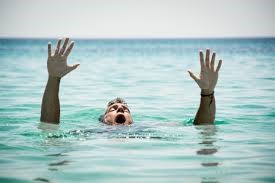Could YOU survive in the water?
It’s coming to that time of the year for the Northern States that water temperatures start falling. For the more southern States such as Tasmania, South Australia and Victoria not to mention the bottom end of Western Australia it’s pretty much an all-year-round issue.

While you may have undertaken a Shipboard Safety Skillset course (previously Elements of Shipboard Safety or ESS) the question is…
…if you found yourself in the water, do you know how to survive?
Having to survive in the water after your vessels sinks or if you fall overboard can be a terrifying ordeal and one that we hope you or your crew don’t have to go through!
The sad fact is that most people don’t really consider it until it’s too late. And when it’s too late it’s exactly that, too late and the chance of survival, especially in colder waters lessens by the second!
Do you take into account how to survive if you found yourself in the water with other people around you or worse still if you’re alone?
While it’s a situation that we all hope doesn’t happen, the simple fact is that every time you put to sea there is a possibility you may find yourself in the water waiting to be rescued.
These are some of the major factors influencing your survival. If nobody knows you’re in the water then that’s a major problem to start with. Not having a lifejacket on puts you in a serious survival situation.
Where you are, what you’re wearing, and the prevailing conditions all represent major problems in surviving!
If you’re 50nm offshore and find yourself in the water with no lifejacket or anything else to support you in the water and nobody knows… then you’re in a heap of trouble. Survival in this situation is not impossible, but to be honest, chances diminish by the minute.
Hypothermia is a major issue no matter where you are. During our training sessions too many crew members thought that hypothermia didn’t happen in the tropics. Simple fact is that it does!
The very first thing you need to do is ensure everybody is accounted for then check for injuries. Once you’ve dealt with the injuries the next step is critical to everyone’s survival because it’s one of the biggest dangers you’ll face.
Panic is the one thing that’s hard to control because suddenly finding yourself in the water miles from anywhere is a traumatic experience.
If you’re the Master or person in control, it’s critical for all that you get everyone calmed down, easy to say: not so easy to do, but it’s a major step to surviving.
If there’s more than one person then you use the HUDDLE technique. This is where you all huddle together in a group to reduce the heat loss of all persons.
Wearing a lifejacket or PFD allows you to draw your knees to your chest and your arms to your sides. Huddling with other people in the water lessens the loss of body heat and is good for morale.
By huddling together, you make it easier for rescuers to see you in the water. A group huddling together with lifejackets on is much easier to spot than if you were alone in the water!

If you’re alone in the water you need to use the HELP which stands for Heat Escape Lessing Posture to minimise the amount of heat loss from your body.
A position for floating in water when wearing a life jacket and awaiting rescue. You draw up your knees to your chest, hold your arms at your sides and fold your lower arms against your chest.

Our top recommendations to help you survive are:
The big tip is to ensure you conduct regular training (drills) that take into account in-water survival techniques.
Our number one tip is for crew working in rough (adverse) weather or operating a Master only vessel at sea is to wear a Personal Locator Beacon (PLB) that’s GPS activated. This greatly increases the potential for you to be recovered quickly which means, you survive!.